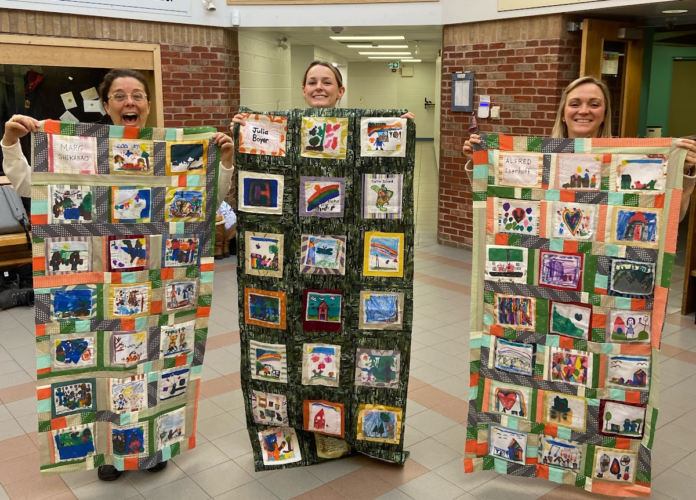Three quilts have gone up at Huntsville’s Riverside Public School to honour children who attended Residential Schools.
Riverside teacher Elaine Christensen says it’s the result of a months-long learning experience that kicked off in an assembly ahead of the National Day for Truth and Reconciliation in September.
She says it taught students about the Residential School system, which continued in classroom learning and student discussions over the coming months, culminating in students drawing pictures that were sewn into quilts by local volunteers.
Grade Two students Carter Morton, Jude Barkey, and Reed Fenwick were among the many Riverside students that drew a picture to go onto the quilts.
For Fenwick, that was children playing in leaves with a big heart behind them, “because the kids at residential schools should [have had] freedom.” Morton drew North America as a turtle, to reflect the Indigenous creation story of Turtle Island. “I wish they got their home back,” he says.
Barkey says even before the initial assembly, he knew the schools were a “very bad thing.” His drawing was of a building flanked by a rainbow and a heart, to show what schools should be like. “It made me feel sad,” says Barkey. “And I’ll tell other people, so they know how bad it was.”
“They were being treated very badly,” says Morton of what he learned. “They would have to wear black shirts, and they would cut their hair short, and they wouldn’t let them say a word in their language.”
“I learned that they just came in and took the kids away from their families, without even asking if they wanted to go,” adds Fenwick.
Morton says they also learned the story behind Orange Shirt Day and B.C. residential school survivor, Phyllis Webstad. He says at first Webstad felt excited to go to a new school, but that didn’t last long.
“Her grandma bought her an orange shirt, and then when she got there they took it away from her forever, and gave her a black shirt,” he says. “It made me feel sad because she didn’t get to keep her favourite shirt.”
Given the dark nature of the subject matter, Christensen says she was concerned about how to broach the topic with her students. However, she says the story walk on the nearby trail, set up by fellow teacher Meghan deLagran, helped them understand at their own pace.
“Just based on that story, they really thought about how that would be for them in a similar situation,” says Christensen. “So we took it from where they were with their maturity with the subject matter. And we found that with children’s books like those and others, they were able to identify in a way that they were ready.”
Christensen adds seeing the quilts all come together with help from the community really made the students feel like they were sharing their voices.
“The excitement in their faces when they saw it sewn together, and the beautiful colours, and seeing all their ideas unified,” says Christensen. “They were able to think about how they appreciated the community involvement, and that even though they are young eight-year-olds, what they have to say and how they feel is important.”





